香港中文大学:Networked Fairness in Cake Cutting

Networked Fairness in Cake Cutting Xiaohui Bei Youming Qiao Shengyu Zhang
Networked Fairness in Cake Cutting Xiaohui Bei Youming Qiao Shengyu Zhang
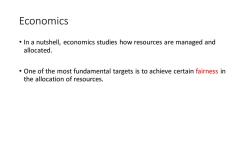
Economics In a nutshell,economics studies how resources are managed and allocated. One of the most fundamental targets is to achieve certain fairness in the allocation of resources
Economics • In a nutshell, economics studies how resources are managed and allocated. • One of the most fundamental targets is to achieve certain fairness in the allocation of resources
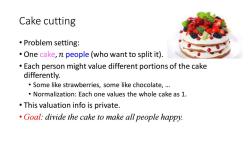
Cake cutting ·Problem setting: One cake,n people (who want to split it). Each person might value different portions of the cake differently. Some like strawberries,some like chocolate,.. Normalization:Each one values the whole cake as 1. This valuation info is private. Goal:divide the cake to make all people happy
Cake cutting • Problem setting: • One cake, 𝑛 people (who want to split it). • Each person might value different portions of the cake differently. • Some like strawberries, some like chocolate, … • Normalization: Each one values the whole cake as 1. • This valuation info is private. • Goal: divide the cake to make all people happy
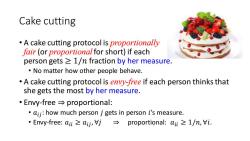
Cake cutting A cake cutting protocol is proportionally fair (or proportional for short)if each person gets =1/n fraction by her measure. No matter how other people behave. A cake cutting protocol is envy-free if each person thinks that she gets the most by her measure. 。Eny-free→proportional: aij:how much person j gets in person i's measure. ·Envy-free:ai≥ai,j→ proportional:aii >1/n,Vi
Cake cutting • A cake cutting protocol is proportionally fair (or proportional for short) if each person gets ≥ 1/𝑛 fraction by her measure. • No matter how other people behave. • A cake cutting protocol is envy-free if each person thinks that she gets the most by her measure. • Envy-free ⇒ proportional: • 𝑎𝑖𝑗 : how much person 𝑗 gets in person 𝑖’s measure. • Envy-free: 𝑎𝑖𝑖 ≥ 𝑎𝑖𝑗 , ∀𝑗 ⇒ proportional: 𝑎𝑖𝑖 ≥ 1/𝑛, ∀𝑖
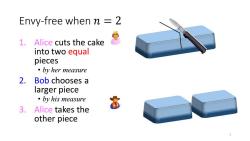
Envy-free when n 2 1.Alice cuts the cake into two equal pieces ·by her measure 2.Bob chooses a larger piece ·by his measure 常 3.Alice takes the other piece 5
5 Envy -free when 𝑛 = 2 1. Alice cuts the cake into two equal pieces • by her measure 2. Bob chooses a larger piece • by his measure 3. Alice takes the other piece
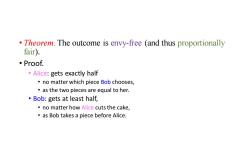
Theorem.The outcome is envy-free (and thus proportionally fair). ●Proof. Alice:gets exactly half no matter which piece Bob chooses, as the two pieces are equal to her. Bob:gets at least half, no matter how Alice cuts the cake, as Bob takes a piece before Alice
• Theorem. The outcome is envy-free (and thus proportionally fair). • Proof. • Alice: gets exactly half • no matter which piece Bob chooses, • as the two pieces are equal to her. • Bob: gets at least half, • no matter how Alice cuts the cake, • as Bob takes a piece before Alice
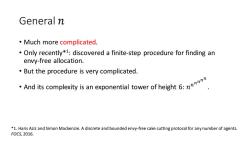
General n Much more complicated. Only recently*1:discovered a finite-step procedure for finding an envy-free allocation. But the procedure is very complicated. And its complexity is an exponential tower of height 6: *1.Haris Aziz and Simon Mackenzie.A discrete and bounded envy-free cake cutting protocol for any number of agents. F0CS,2016
General 𝑛 • Much more complicated. • Only recently*1 : discovered a finite-step procedure for finding an envy-free allocation. • But the procedure is very complicated. • And its complexity is an exponential tower of height 6: 𝑛 𝑛 𝑛 𝑛 𝑛 𝑛 . *1. Haris Aziz and Simon Mackenzie. A discrete and bounded envy-free cake cutting protocol for any number of agents. FOCS, 2016

Envy on networks Envy usually happens between people knowing each other. We don't envy someone we don't even know. ·Envy on networks: An undirected graph G=(V,E). ·V={agents} ·(i,j)∈E if agent i knows agent j: An allocation is envy-free on G if no agent envies any of her neighbors. An allocation is proportional on G if each agent gets at least the average of her neighbors'total allocation with respect to her own valuation
Envy on networks • Envy usually happens between people knowing each other. • We don’t envy someone we don’t even know. • Envy on networks: • An undirected graph 𝐺 = 𝑉, 𝐸 . • 𝑉 = 𝑎𝑔𝑒𝑛𝑡𝑠 • 𝑖,𝑗 ∈ 𝐸 if agent 𝑖 knows agent 𝑗. • An allocation is envy-free on 𝐺 if no agent envies any of her neighbors. • An allocation is proportional on 𝐺 if each agent gets at least the average of her neighbors’ total allocation • with respect to her own valuation
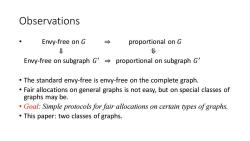
Observations Envy-free on G → proportional on G 业 业 Envy-free on subgraph G proportional on subgraph G' The standard envy-free is envy-free on the complete graph. Fair allocations on general graphs is not easy,but on special classes of graphs may be. Goal:Simple protocols for fair allocations on certain types ofgraphs. This paper:two classes of graphs
Observations • Envy-free on 𝐺 ⇒ proportional on 𝐺 ⇓ ⇓ Envy-free on subgraph 𝐺 ′ ⇒ proportional on subgraph 𝐺 ′ • The standard envy-free is envy-free on the complete graph. • Fair allocations on general graphs is not easy, but on special classes of graphs may be. • Goal: Simple protocols for fair allocations on certain types of graphs. • This paper: two classes of graphs
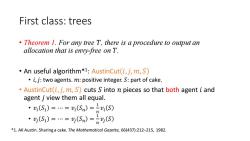
First class:trees Theorem 1.For any tree T,there is a procedure to output an allocation that is envy-free on T. An useful algorithm*1:AustinCut(i,j,m,S) i,j:two agents.m:positive integer.S:part of cake. AustinCut(i,j,m,S)cuts S into n pieces so that both agent i and agent j view them all equal. ·(S)==(Sn)=S) ·(S1)=…=(Sm)=(S) *1.AK Austin.Sharing a cake.The Mathematical Gazette,66(437):212-215,1982
First class: trees • Theorem 1. For any tree 𝑇, there is a procedure to output an allocation that is envy-free on 𝑇. • An useful algorithm*1 : AustinCut 𝑖,𝑗, 𝑚, 𝑆 • 𝑖,𝑗: two agents. 𝑚: positive integer. 𝑆: part of cake. • AustinCut 𝑖,𝑗, 𝑚, 𝑆 cuts 𝑆 into 𝑛 pieces so that both agent 𝑖 and agent 𝑗 view them all equal. • 𝑣𝑖 𝑆1 = ⋯ = 𝑣𝑖 𝑆𝑛 = 1 𝑛 𝑣𝑖 𝑆 • 𝑣𝑗 𝑆1 = ⋯ = 𝑣𝑗 𝑆𝑛 = 1 𝑛 𝑣𝑗 𝑆 *1. AK Austin. Sharing a cake. The Mathematical Gazette, 66(437):212–215, 1982
按次数下载不扣除下载券;
注册用户24小时内重复下载只扣除一次;
顺序:VIP每日次数-->可用次数-->下载券;
- 《金陵科技学院学报》:高形变二维码识别算法设计与实现.pdf
- 东北大学:《可信计算基础》课程教学资源(试卷习题)期末考试样题.doc
- 东北大学:《可信计算基础》课程教学资源(PPT课件讲稿)TSS示例程序.pptx
- 东北大学:《可信计算基础》课程教学资源(PPT课件讲稿)TSS软件栈 TSS-TCG Software Stack.pptx
- 东北大学:《可信计算基础》课程教学资源(PPT课件讲稿)第6讲 可信启动.pptx
- 东北大学:《可信计算基础》课程教学资源(PPT课件讲稿)第6章 TPM核心功能.pptx
- 东北大学:《可信计算基础》课程教学资源(PPT课件讲稿)第6讲 可信计算基础.pptx
- 东北大学:《可信计算基础》课程教学资源(PPT课件讲稿)第4讲 公钥基础设施(PKI).ppt
- 东北大学:《可信计算基础》课程教学资源(PPT课件讲稿)第三讲 认证技术与数字签名.ppt
- 东北大学:《可信计算基础》课程教学资源(PPT课件讲稿)第二章 密码学技术.ppt
- 东北大学:《可信计算基础》课程教学资源(PPT课件讲稿)第一章 概述(主讲:周福才).pptx
- 东北大学:《信息安全专业概论与职业发展》课程教学资源(PPT课件讲稿)第一讲 浅析专业与兴趣(主讲:周福才).pptx
- 东北大学:《信息安全专业概论与职业发展》课程教学资源(PPT课件讲稿)第三讲 信息安全专业规范.pptx
- 东北大学:《信息安全专业概论与职业发展》课程教学资源(PPT课件讲稿)第二讲 信息安全概念、发展和现状.pptx
- 谷歌研究院(Google)数学之美与浪潮之巅.pdf
- 四川省普通高等学校专升本《大学计算机基础》考试大纲.pdf
- 华东理工学院:《数字图像处理 Digital Image Processing》课程教学资源(课件讲稿)第四章 灰度图像.pdf
- 华东理工学院:《数字图像处理 Digital Image Processing》课程教学资源(课件讲稿)第六章 分割.pdf
- 华东理工学院:《数字图像处理 Digital Image Processing》课程教学资源(课件讲稿)第五章 几何变换.pdf
- 华东理工学院:《数字图像处理 Digital Image Processing》课程教学资源(课件讲稿)第七章 彩色图像处理.pdf
- 香港中文大学:Sensitivity Conjecture and Log-rank Conjecture for functions with small alternating numbers.pptx
- 香港中文大学:Fast quantum algorithms for Least Squares Regression and Statistic Leverage Scores.pptx
- 香港中文大学:Fourier sparsity, spectral norm, and the Log-rank conjecture(short).pptx
- 香港中文大学:Fourier sparsity, spectral norm, and the Log-rank conjecture(long).pptx
- 香港中文大学:Efficient protocols for generating bipartite classical distributions and quantum states.pptx
- 香港中文大学:On the complexity of trial and error.pptx
- 香港中文大学:A quantum protocol for sampling correlated equilibria unconditionally and without a mediator.pptx
- 香港中文大学:Quantum strategic game theory.ppt
- 香港中文大学:On the power of lower bound methods for quantum one-way communication complexity.ppt
- 香港中文大学:An Introduction to Quantum Computing in Theoretical Computer Science.ppt
- 香港中文大学:Random Walk on Graphs and its Algorithmic Applications.ppt
- 香港中文大学:《Probability and Statistics for Engineers》课程教学资源(课件讲稿)Sample space and probability.pdf
- 香港中文大学:《Probability and Statistics for Engineers》课程教学资源(课件讲稿)Sample space and probability.pptx
- 香港中文大学:《Probability and Statistics for Engineers》课程教学资源(课件讲稿)Discrete random variables.pdf
- 香港中文大学:《Probability and Statistics for Engineers》课程教学资源(课件讲稿)Discrete random variables.pptx
- 香港中文大学:《Probability and Statistics for Engineers》课程教学资源(课件讲稿)Further Topics on Random Variables.pdf
- 香港中文大学:《Probability and Statistics for Engineers》课程教学资源(课件讲稿)Further Topics on Random Variables.pptx
- 香港中文大学:《Probability and Statistics for Engineers》课程教学资源(课件讲稿)General random variables.pdf
- 香港中文大学:《Probability and Statistics for Engineers》课程教学资源(课件讲稿)Limit Theorems.pdf
- 香港中文大学:《Probability and Statistics for Engineers》课程教学资源(课件讲稿)Limit Theorems.pptx
